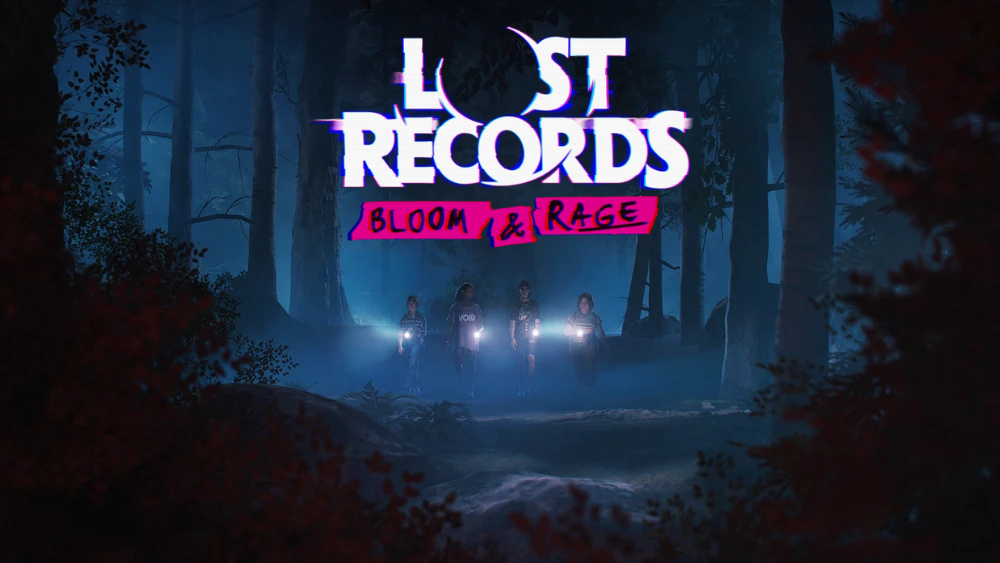Don’t Nod has definitely more than made their mark in the world of narrative games. With Life is Strange’s debut ten years ago, they carved out a new niche – focusing in on the emotional storytelling behind characters and allowing players to see their own experiences represented in gaming. It’s an empowering legacy that changed games for players like myself with every sequel, even evolving in Tell Me Why – another powerhouse that refocused that emotional depth. With all that in mind, Lost Records: Bloom & Rage, Don’t Nod’s latest episodic release so far feels like a banger of an addition to their roster.
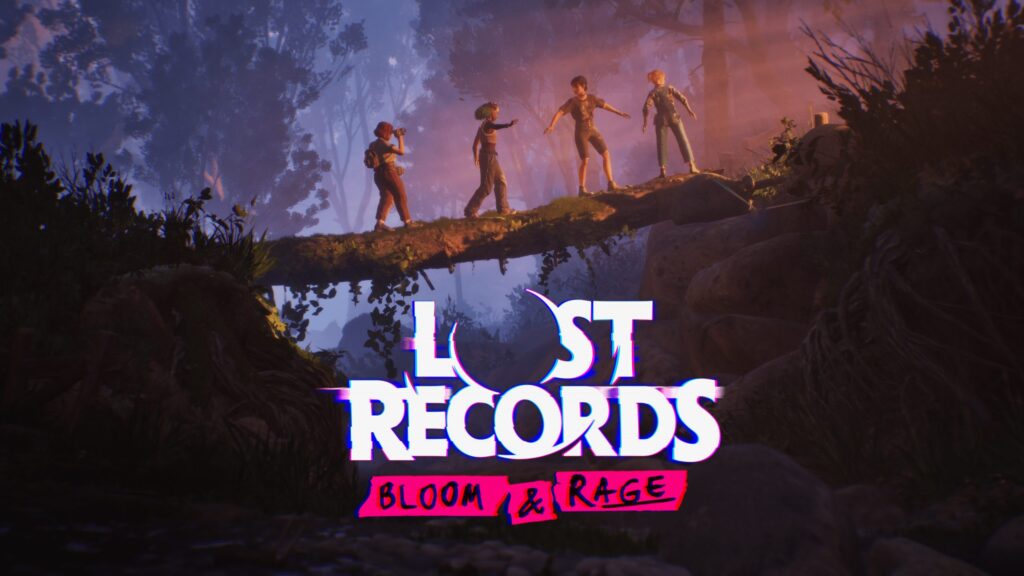
Lost Records: Bloom & Rage – Tape 1 introduces players to Swann Holloway in the present timeline set in 2022. After 27 years, Swann returns to Velvet Cove after leaving it all behind one fateful summer in 1995. A lot can happen in one summer, and Swann’s return stirs memories and we begin shifting between the timelines as she reconnects with her friends in the present. Back in the 1995 timeline, we play as teenage Swann, who is preparing to leave Velvet Cove, when she forms a bond with Amanda, Nora, and Kat. After a run-in with Dylan and her boyfriend, Corey, Swann is singled out and humiliated. Kat comes to the rescue, though, and it’s soon that we learn that she’s Dylan’s younger sister. The altercation spirals leading to Nora and Amanda also jumping in to stand up for Swann before Corey grabs Amanda’s keys and tosses them over a fence. While searching for the keys, the girls connect. Through their shared experiences as outcasts, they band together and form Bloom & Rage – a group inspired by the girl’s own love of riot-grrrl music and urge to rebel against Corey and Dylan.
In the present day, it’s revealed early on that one of the girls has received an eerie package addressed to Bloom & Rage. While this is a driving force for the first episode pulling them back together, the friends have much ground to cover before its contents can be revealed. 27 years is a long time and it’s clear there’s a lot to unpack from that summer. The character development across this episode really pulls from each timeline as we meet the girls both as teenagers and adults and learn more about their lives and what happened that summer. Tape 1 definitely has its work cut out for it. Not only to introduce the characters but also to engage us in the mystery – yet it does it with total confidence.
As protagonists go, Swann has quickly become one of my favourite Don’t Nod characters given how earnest and approachable she is across each of the timelines. Playing as her while she’s getting to know her new friends is quite an intimate experience, with each of the girls having their own individual connection to explore. From her design to her dialogue, the nuance around her experience is absolutely a focus for the game, with Swann’s experience remaining the player’s focus throughout the game. Also being 1995, Swann doesn’t have a phone or even a journal. She has a camcorder that acts as her way to capture the world of Velvet Cove. Swann’s interactions through it show that she is quite introverted, yet as she opens up to her newfound friends, her footage becomes more of a collective memoir of the girls connecting.
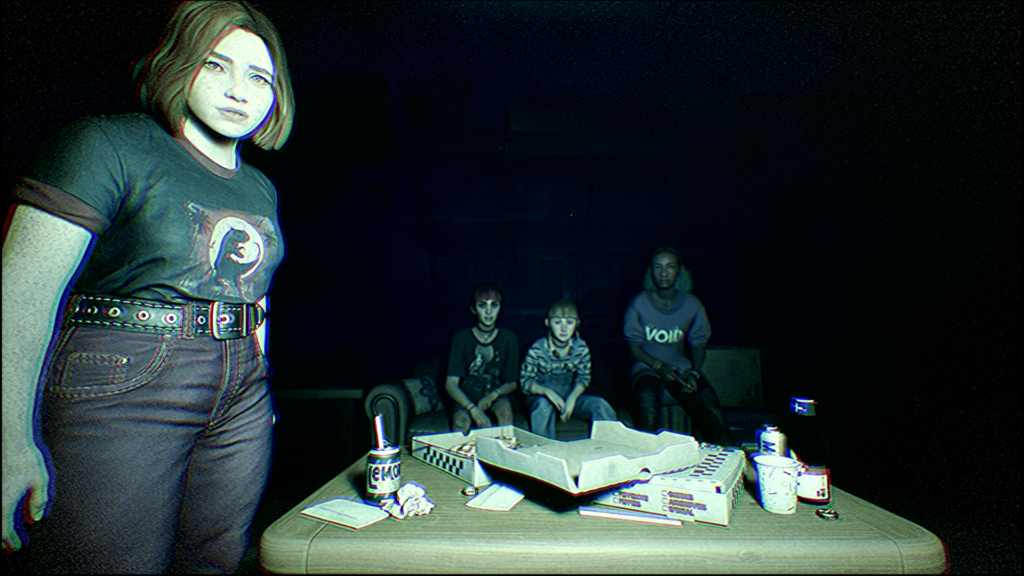
As Swann’s character develops through Tape 1, players get to really savour this summer through her eyes with the present day, even allowing players to reminisce and play small snippets of dialogue past. These really add weight to the significance of that summer in her life, even if the group promised to keep what happened a secret. Her camcorder is also such a unique mechanic that allows us to see the world through her eyes and even hear her commentary as she collects little memoirs of everything from her cat, the movie rental store, and even the bullies the group contends with. Unlike Max Caulfied’s Polaroid camera, the camcorder is always within reach. Players can film their own moments and even edit the footage like you would in real life.
The camcorder really showcases the world with ease. We feel that same urge as Swann to capture everything, and thankfully, there are plenty of things to film around the locations in the game. Tape 1 features a group of story memoirs along with collectible footage that focuses on things out in the world, such as graffiti, birds, and even other characters. It’s hard not to feel that same nostalgia as Swann when you’re walking around searching for things to film before moving on in the game. I really enjoyed how you could personalise that footage, from zooming in to panning across an object or waiting for that perfect moment to press record. The footage becomes more than just a mechanic but something more personal that connects the player to the game on a deeper level.
Conversations in the game also feel much deeper and reactive. It’s a focus on the flow of the conversation that feels like a step forward for Don’t Nod’s signature formula. Here, players can choose prompts as conversations happen without that awkward pause to respond. Some prompts even time out on the screen or require players to look at certain characters before responding. Some sequences see players engaging in conversations without interacting with characters, which feels like a drastic improvement from how Swann interacts with those around her, allowing for smaller interactions between conversations. In a lot of ways, it’s a decent quality-of-life change that I never knew I needed till I saw how it changed the flow of the game.
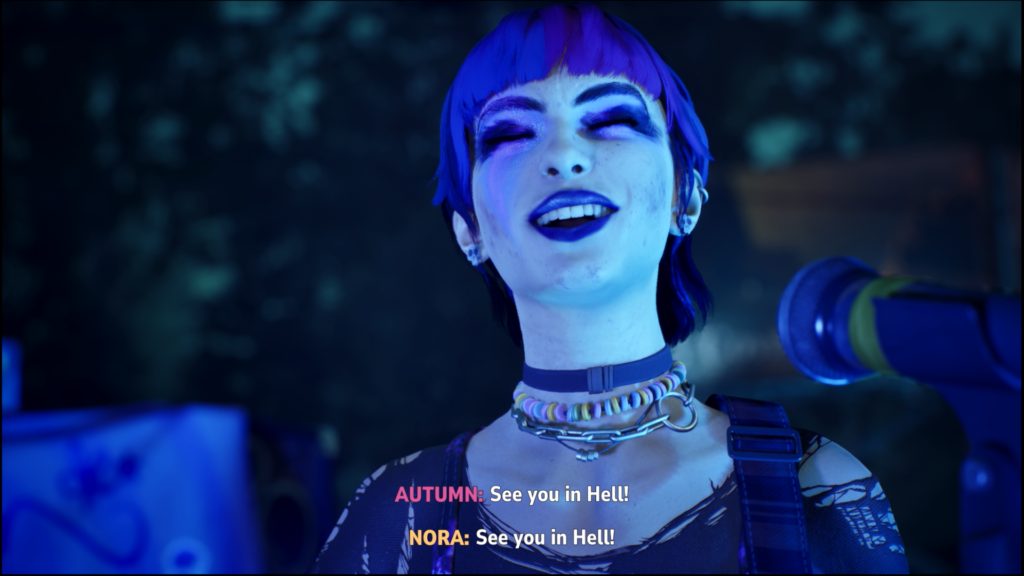
Choices in the game focus on Swann and her relationships with her friends, both as teenagers and adults. After Tape 1, players can even compare their relationships with each timeline and go back through their choices. Unlike the other games though, the majority of the choices appear to be pretty siloed to Swann’s interactions with the characters across the episode. Even small decisions such as hugging a character you haven’t seen in 27 years give emphasis to how fragile the girls’ bond is after so much time. It’s clear that summer had lasting, huge ramifications for the girls’ lives. I really appreciated that level of connection being so well explored as the girls reconnect and remember what happened. It does feel like bigger choices aren’t the focus here, and I feel like I’m okay with that so far. Through Swann’s interactions with the girls, it does allow her to choose a favourite, even having the opportunity to call them on the home phone. Yet another tender detail on the game’s nostalgia train that gives it that unwavering authenticity.
From the opening of the game, we see a face mask on the car dash, with that COVID era referenced in conversation so similarly to how it pops up in everyday life for players. The connection to this game feels bolder thanks in no small part to those smaller set dressings. It’s another point of relation to the player that is almost innocuous, yet it builds out the game world. Reconnecting after isolation and how Swann navigates that nostalgia for this world really adds nuance to the experience. Even allowing players to pick up and interact with times builds out the game’s world with ease. It shows Don’t Nod’s experience in narrative design, with everything functioning around the player to engage them with the world within the game.
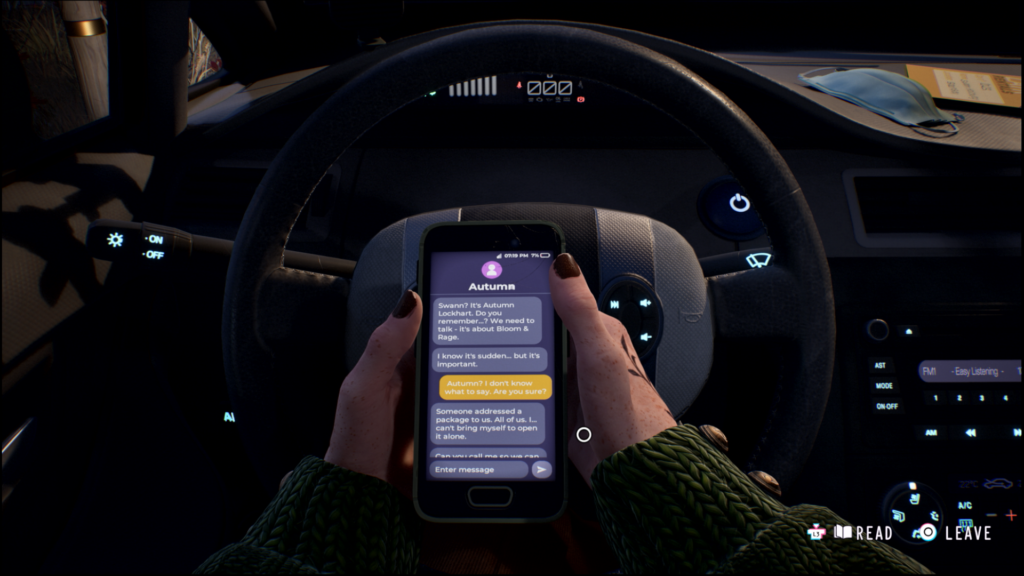
As aesthetics go, Lost Records: Bloom & Rage oozes that signature art style we know well from the Life is Strange series only here it’s on a whole other level across each timeline. While the present is far more grounded and detailed, the past feels much more dreamlike and brighter. Playing through Swann’s memories feels like stepping into a film almost, with that nostalgia for a summer long ago taking hold before we’re pulled back into the present. It does wonders for how the game positions the player with Swann as she remembers what happened that summer with her friends. It’s a cathartic experience, that leaves the player longing for that summer while shifting the tension away from rushing those pivotal moments.
It’s very easy to see how the game leans into its influences while also making them their own. With Velvet Cove dripping in Twin Peaks vibes, it’s hard not to appreciate those references, like how the birds and locations feel in contrast. It’s a very distinct energy that carries across each timeline, with things seeming peculiar despite how they’re perceived. Even as the girls meet in the present to discuss the ramifications of the past and delve back into that paranormal intrigue, the sense of mystery continues to grow. I really appreciated the meaning across the game, from subtle easter eggs like owls watching over playgrounds to the trees in the woods having eye-like markings. There’s still a lot we don’t know about Velvet Cove, but also a lot of intrigue building within the game for how this summer plays out. The game blends it with its own signature neon purple that really pulls the energy towards things in this town, being not all that they seem to be. It’s as eerie as it is gorgeous to behold, yet the truth of the girls’ experiences still evades the player even as they encounter some paranormal happenings in the lead-up to the conclusion of the tape.
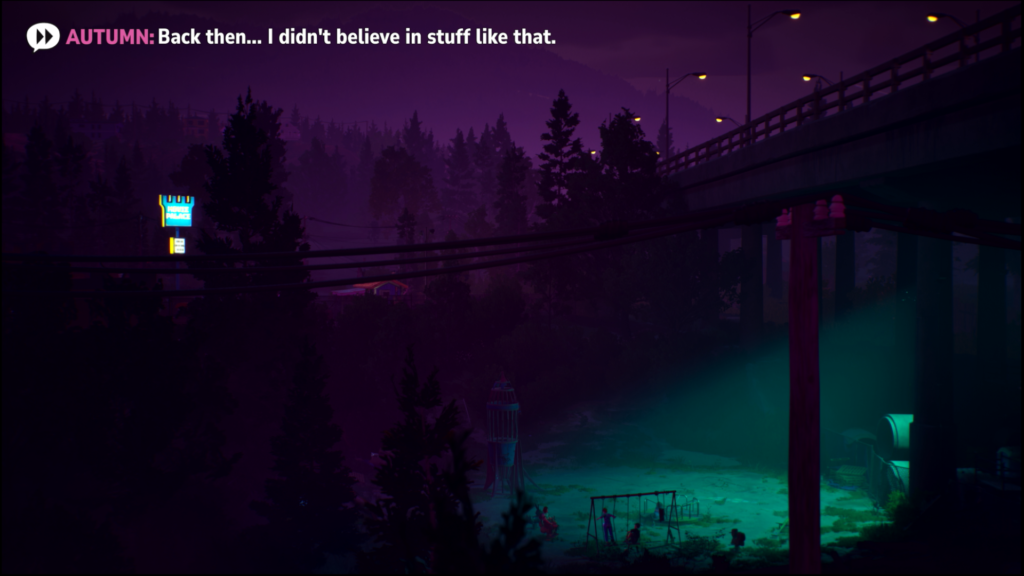
Where the game began to wan for me was with how it approached the wider soundtrack. Bloom & Rage’s battle cry track, See You in Hell, gets its moment, but other songs never quite feel like they get theirs. Even in the moments where Swann is able to sit and exist in the world in a similar way to the other games, here, there just wasn’t that focus on a song to accompany that moment. Tape 1 does feature some great tracks, and yet during my playtime, it was only See You in Hell and the track from the end of the episode, Myth by Beach House, that really hit for me. The latter plays during the final moments on a gorgeous and heartbreaking sequence that honestly brings the episode home for me. I’d be worried if I didn’t remember that. It could be that they didn’t wish to take away from these emotional beats in the game, but personally, I really saw those moments as lacking in the wider narrative across the episode. Given how cinematic Tape 1 is, having more time to really feel scenes like Don’t Nod’s typical flavour would’ve been incredible.
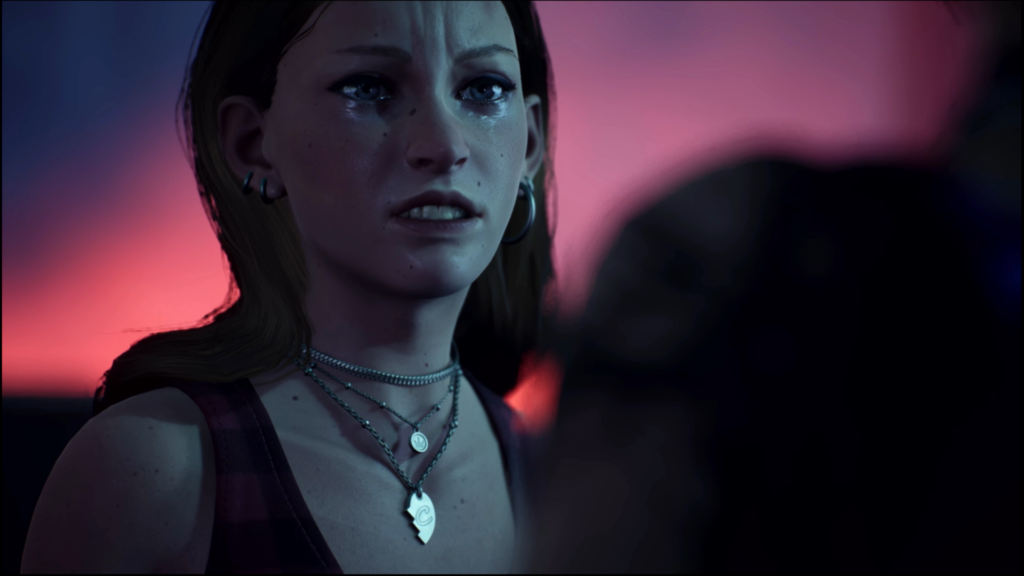
Seeing this world take hold from the onset of the game, it’s impossible not to feel along for the ride again. Don’t Nod show their maturity with this one, melding that Life is Strange blueprint into something new. This has to be my favourite Don’t Nod experience purely off of how it feels to explore this world with the characters. Not knowing what happened that summer beckons us to delve into the intrigue of the world. While I won’t spoil how Tape 1 ends, it’s a shock that leaves the girls reeling to comprehend not only what they’ve discovered out there in the woods but also what those final moments will mean for the group’s fate that summer. With things already taking a turn toward the paranormal, and the present-day teasing of a secret that they’d never speak of again – a lot rides on Tape 2. While I want nothing more than to learn what happens next, being able to sit with Tape 1 really emphasises the gravity of that ending. It’s also allowed me to go back and play through sections, hunting for hints and other clues in the lead-up to that ending. It feels like there is still a lot of ground to cover in the game, with questions waiting to be answered. Even the package that brought the girls back together is still waiting to be opened.
/*! elementor – v3.23.0 – 05-08-2024 */
.elementor-heading-title{padding:0;margin:0;line-height:1}.elementor-widget-heading .elementor-heading-title[class*=elementor-size-]>a{color:inherit;font-size:inherit;line-height:inherit}.elementor-widget-heading .elementor-heading-title.elementor-size-small{font-size:15px}.elementor-widget-heading .elementor-heading-title.elementor-size-medium{font-size:19px}.elementor-widget-heading .elementor-heading-title.elementor-size-large{font-size:29px}.elementor-widget-heading .elementor-heading-title.elementor-size-xl{font-size:39px}.elementor-widget-heading .elementor-heading-title.elementor-size-xxl{font-size:59px}
LOST RECORDS: BLOOM & RAGE – TAPE 1 REVIEW
FANTASTIC
8.5
Don’t Nod is SO BACK with Lost Records: Bloom and Rage. Not only does Swann and the camcorder feel new and exciting, but with a location like Velvet Cove oozing that neon-soaked Twin Peaks realness, one can’t help but be along for the ride. This definitely isn’t a repeat of the same formula either, with the dual timelines narrative adding to the maturity of the game as we relive the summer that was for this girl gang. It’s impossible not to feel along for the ride with that same relatability at its core.
Tape 1 is loaded with incredible soundtrack choices, though some don’t quite get the attention they deserve, yet in those final moments, they bring it home so effortlessly – proving they have what it takes to tell a different story. I can’t wait to see how Lost Records: Bloom and Rage concludes in Tape 2, given how many more questions there are still to answer. If anyone wants me, I’ll be replaying Tape 1.
PROS
- Cinematic as ever
- Swann and her friends are incredibly nuanced
- The setting oozes Twin Peaks nostalgia
- Camcorder is a neat, personal mechanic
- Dialogue system feels responsive and natural
CONS
- Soundtrack deserves more attention outside of pivotal moments
Reviewed on PS5. A review code was provided by the Publisher for purposes of this review.
